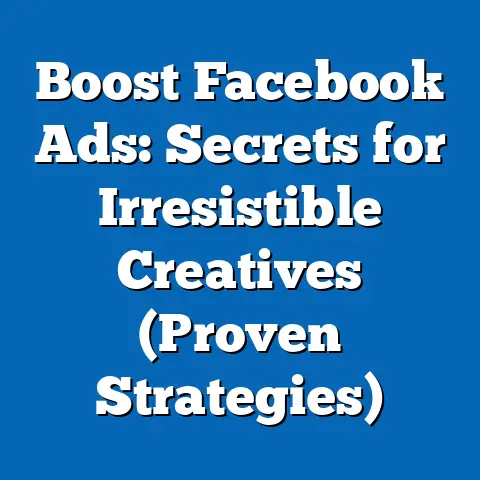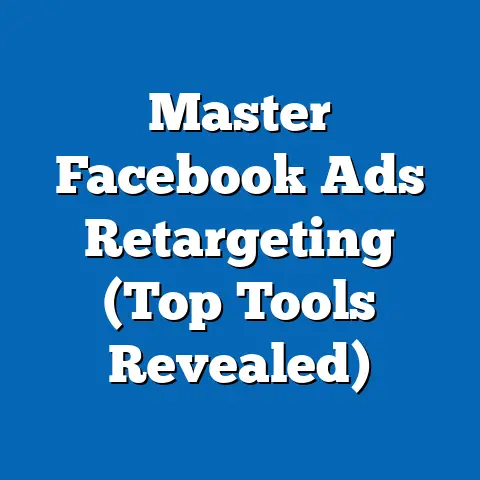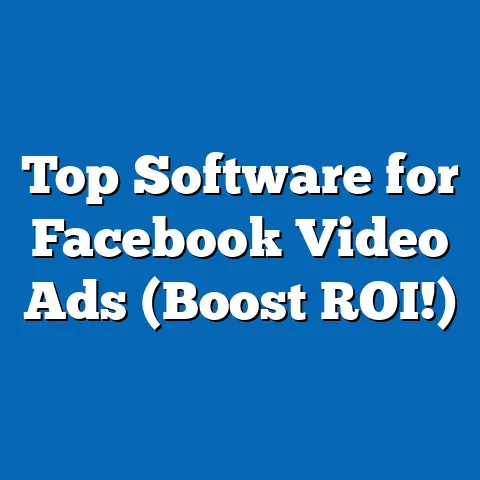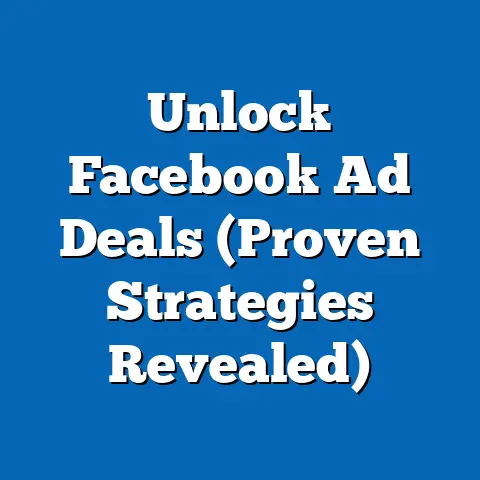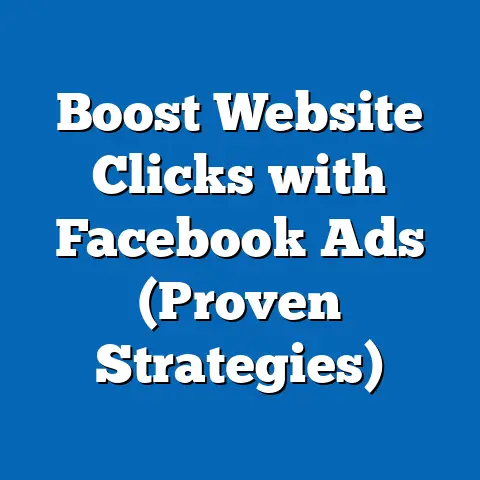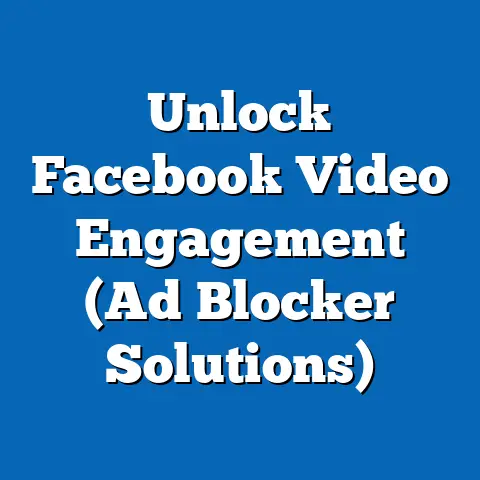Master Facebook Ads Hacks (Unlock Proven Strategies)
I’ve been in the digital marketing game for quite a while now, and one thing I’ve consistently observed is the ever-evolving nature of Facebook Ads. What worked like gangbusters a year ago might barely move the needle today. Businesses often find themselves stuck in a cycle of rising costs, fierce competition, and the seemingly impossible task of pinpointing the right audience. I’ve seen firsthand the frustration when meticulously crafted ads fall flat, despite the hours and dollars poured into them. It’s disheartening, to say the least.
But here’s the good news: there’s always a way to adapt, to innovate, and to ultimately, succeed. That’s where the concept of “hacks” comes in. I’m not talking about unethical shortcuts, but rather, clever, often overlooked strategies that can significantly amplify your ad performance. Think of them as the secret sauce that separates a mediocre campaign from a truly exceptional one.
In this guide, I’m going to pull back the curtain and reveal proven Facebook Ads hacks that I’ve personally used and witnessed delivering incredible results. We’ll tackle everything from laser-focused audience targeting to crafting irresistible ad creatives and optimizing your campaigns for maximum ROI. My goal is to equip you with the knowledge and tools you need to not just survive, but thrive in the dynamic world of Facebook advertising. Let’s dive in!
Understanding Facebook Ads Fundamentals
Before we jump into the juicy hacks, let’s quickly recap the core components of Facebook Ads. Think of this as our foundation – understanding how the system works is crucial to making our hacks truly effective.
At its heart, Facebook advertising revolves around a few key elements:
- Ad Objectives: What do you want to achieve? Are you aiming for brand awareness, website traffic, lead generation, or sales conversions? Your objective dictates how Facebook optimizes your ad delivery.
- Target Audiences: Who are you trying to reach? Facebook offers a wealth of targeting options, from demographics and interests to behaviors and connections.
- Ad Formats: How will your ad look? Choose from single images, videos, carousels, collections, and more. The format should align with your objective and target audience.
- Bidding Strategies: How much are you willing to pay? You can choose automatic bidding, where Facebook optimizes your bid for the best results, or manual bidding, where you set your own bid limits.
Understanding how these elements interact is key. For instance, a visually stunning video ad targeting a broad audience with a brand awareness objective will perform very differently from a carousel ad with a direct response CTA targeting a custom audience of website visitors.
Takeaway: Knowing the fundamentals of Facebook Ads is the bedrock upon which all successful strategies are built. Without a solid grasp of these elements, even the most ingenious hacks will fall short.
The Power of Audience Targeting Hacks
Okay, now we’re getting to the good stuff! Audience targeting is where the magic truly happens in Facebook Ads. It’s not enough to have a great product or a compelling offer; you need to get it in front of the right people. And that’s where these targeting hacks come into play.
Custom Audiences: Unleash the Power of Your Existing Data
Custom Audiences are, in my opinion, one of the most underutilized yet powerful targeting tools in Facebook Ads. They allow you to upload your own customer lists (email addresses, phone numbers, etc.) or leverage website traffic and app activity to create highly targeted segments.
Here’s how to make the most of Custom Audiences:
- Customer Lists: Upload your customer lists and create a Custom Audience. This is perfect for re-engaging existing customers with special offers or promoting new products. Make sure your list is clean and properly formatted for best results.
- Website Traffic: Install the Facebook Pixel on your website and create Custom Audiences based on website visitors. You can segment visitors based on specific pages they visited, time spent on site, or actions taken (e.g., added items to cart but didn’t purchase).
- App Activity: If you have a mobile app, you can create Custom Audiences based on app users and their in-app behavior.
Example: I once worked with an e-commerce client who was struggling to drive repeat purchases. We created a Custom Audience of customers who had purchased in the past but hadn’t made a purchase in the last 6 months. We then ran a targeted campaign with a special discount code, resulting in a 30% increase in repeat purchases.
Lookalike Audiences: Expand Your Reach to Similar Customers
Lookalike Audiences are like gold dust. They allow you to find new customers who share similar characteristics and behaviors to your best existing customers. Facebook analyzes your source audience (e.g., a Custom Audience of your top-spending customers) and identifies common traits, then finds other users who match those traits.
Tips for creating effective Lookalike Audiences:
- Use High-Quality Source Audiences: The better your source audience, the better your Lookalike Audience will be. Focus on using audiences that represent your ideal customer profile.
- Experiment with Different Lookalike Sizes: Facebook allows you to choose the size of your Lookalike Audience, ranging from 1% (most similar) to 10% (broader reach). Test different sizes to find the sweet spot for your campaign.
- Layer on Additional Targeting: Don’t rely solely on the Lookalike Audience. Layer on additional demographic or interest-based targeting to further refine your audience.
Example: I helped a subscription box company scale their customer base by creating a Lookalike Audience based on their existing subscribers. We targeted the top 1% of users most similar to their subscribers, which resulted in a significant increase in conversion rates and a lower cost per acquisition.
Behavioral and Demographic Targeting: Dive Deep into User Data
Facebook collects a vast amount of data on its users, including their interests, behaviors, demographics, and more. This allows you to create highly targeted audiences based on specific criteria.
Here are some advanced behavioral and demographic targeting tips:
- Detailed Targeting Expansion: Enable “Detailed Targeting Expansion” to allow Facebook to show your ads to people beyond your initial targeting criteria if it thinks they’re likely to convert.
- Interest Stacking: Combine multiple related interests to create a more specific audience. For example, targeting users interested in both “yoga” and “meditation.”
- Life Events: Target users who have recently experienced a major life event, such as getting married, moving to a new city, or starting a new job.
Example: I ran a campaign for a local gym targeting users who had recently moved to the area and were interested in fitness. We offered a special introductory rate, which resulted in a significant influx of new members.
Exclusion Targeting: Stop Wasting Money on Irrelevant Audiences
Just as important as targeting the right people is excluding the wrong people. Exclusion targeting allows you to prevent your ads from being shown to specific audiences, saving you money and improving your campaign performance.
Common use cases for exclusion targeting:
- Existing Customers: Exclude your existing customers from acquisition campaigns to avoid wasting ad spend on people who have already purchased from you.
- Employees: Exclude your employees from seeing your ads (unless you specifically want them to).
- Competitor Audiences: Exclude users who are interested in your competitors’ products or services.
Takeaway: Effective audience targeting is the foundation of any successful Facebook Ads campaign. By leveraging Custom Audiences, Lookalike Audiences, behavioral targeting, and exclusion targeting, you can ensure that your ads are seen by the people who are most likely to convert.
Creative Hacks for Compelling Ad Content
You’ve got your targeting down, now it’s time to make your ads shine! In a sea of endless scrolling, your ad needs to grab attention, convey your message, and inspire action. Here are some creative hacks to help you create compelling ad content:
Eye-Catching Visuals: Stop the Scroll
Visuals are the first thing people see, so they need to be attention-grabbing and relevant.
Tips for creating visually appealing graphics and videos:
- Use High-Quality Images and Videos: Blurry or pixelated visuals are a major turn-off. Invest in high-quality images and videos that showcase your product or service in the best light.
- Experiment with Different Visual Styles: Test different visual styles to see what resonates best with your audience. Consider using bright colors, bold typography, and engaging animations.
- Focus on Mobile-First Design: Most Facebook users are on mobile, so make sure your visuals are optimized for smaller screens.
Example: I worked with a clothing brand that was using generic stock photos in their ads. We replaced them with high-quality lifestyle images featuring real people wearing their clothes, which resulted in a significant increase in click-through rates and conversions.
A/B Testing: Find Your Winning Formula
A/B testing (also known as split testing) is the process of testing different versions of your ad to see which performs best. This is crucial for optimizing your ad creatives and copy.
How to effectively A/B test your ads:
- Test One Element at a Time: To get accurate results, only test one element at a time (e.g., headline, image, CTA).
- Use Facebook’s Built-In A/B Testing Tool: Facebook offers a built-in A/B testing tool that makes it easy to create and track your tests.
- Analyze Your Results and Iterate: Once you have enough data, analyze your results and identify the winning variation. Then, use that as your baseline and test another element.
Example: I helped a SaaS company improve their ad performance by A/B testing different headlines. We tested headlines that focused on different benefits of the product, and we found that headlines that emphasized the time-saving aspect of the product performed best.
Strong Calls-to-Action (CTAs): Tell Them What to Do
Your call-to-action (CTA) is the final nudge that encourages people to take action. It should be clear, concise, and compelling.
Examples of effective CTAs:
- Shop Now: Perfect for e-commerce businesses.
- Learn More: Ideal for lead generation campaigns.
- Sign Up: Great for subscription services or email list building.
- Download Now: Use this for offering free resources like ebooks or guides.
Tips for crafting effective CTAs:
- Use Action Verbs: Start your CTA with an action verb (e.g., “Shop,” “Learn,” “Sign Up”).
- Create a Sense of Urgency: Use words like “Now” or “Today” to create a sense of urgency.
- Make it Prominent: Ensure your CTA is visually prominent and easy to click.
Example: I worked with a local restaurant that was running a Facebook ad campaign to promote their new menu. We used the CTA “Order Now” and linked directly to their online ordering system, which resulted in a significant increase in online orders.
Storytelling: Connect on an Emotional Level
People are drawn to stories. Incorporating storytelling into your ad copy can create an emotional connection with potential customers and make your ads more memorable.
Techniques for incorporating storytelling into your ads:
- Share Customer Testimonials: Feature real customer stories that highlight the benefits of your product or service.
- Focus on the Problem and Solution: Tell a story about a common problem that your target audience faces and how your product or service provides the solution.
- Use Evocative Language: Use descriptive language that paints a vivid picture in the reader’s mind.
Example: I helped a non-profit organization create a Facebook ad campaign to raise awareness about their cause. We shared stories of people who had been helped by the organization, which resonated deeply with viewers and resulted in a significant increase in donations.
Takeaway: Compelling ad content is essential for capturing attention and driving results. By focusing on eye-catching visuals, A/B testing, strong CTAs, and storytelling, you can create ads that resonate with your audience and inspire action.
Optimization Hacks for Increased ROI
Now that you’ve got killer targeting and captivating creatives, let’s talk about maximizing your return on investment (ROI) through optimization. These hacks will help you fine-tune your campaigns for peak performance.
Dynamic Ads: Personalize at Scale
Dynamic Ads are a game-changer for e-commerce businesses. They allow you to automatically personalize your ads based on user behavior and preferences. For example, if someone viewed a specific product on your website, they’ll see an ad featuring that product in their Facebook feed.
How to set up Dynamic Ads:
- Upload Your Product Catalog: Upload your product catalog to Facebook’s Commerce Manager.
- Set Up Your Pixel: Ensure your Facebook Pixel is properly installed and tracking product views, add-to-carts, and purchases.
- Create a Dynamic Ad Campaign: Choose the “Catalog Sales” objective and select your product catalog.
Benefits of Dynamic Ads:
- Increased Relevance: Shows users products they’re actually interested in.
- Higher Conversion Rates: Drives more sales by re-engaging users who have already shown interest.
- Time Savings: Automates ad creation and targeting.
Example: I helped an online shoe retailer increase their sales by 20% by implementing Dynamic Ads. We targeted users who had viewed specific shoes on their website but hadn’t made a purchase, and we showed them ads featuring those shoes with a special discount code.
Retargeting Campaigns: Re-Engage Your Warm Leads
Retargeting campaigns are designed to re-engage users who have previously interacted with your brand, such as website visitors, app users, or people who have watched your videos. These users are already familiar with your brand, so they’re more likely to convert.
Effective retargeting strategies:
- Website Retargeting: Target users who have visited specific pages on your website but haven’t made a purchase.
- Video Retargeting: Target users who have watched a certain percentage of your videos.
- Lead Form Retargeting: Target users who have started filling out a lead form but haven’t submitted it.
Example: I worked with a real estate company that was generating leads through Facebook Ads. We created a retargeting campaign targeting users who had downloaded their free guide to buying a home, and we showed them ads featuring available properties. This resulted in a significant increase in qualified leads.
Budget Optimization: Spend Wisely, Get More
Budget optimization is the process of allocating your budget efficiently across your campaigns and ad sets based on performance data. This ensures that you’re spending your money where it’s most effective.
Techniques for budget optimization:
- Campaign Budget Optimization (CBO): Allow Facebook to automatically allocate your budget across your ad sets based on performance.
- Ad Set Budget Optimization: Set individual budgets for each ad set and monitor their performance closely.
- Performance-Based Adjustments: Regularly review your campaign performance and adjust your budgets accordingly. Increase budgets for high-performing ad sets and decrease budgets for low-performing ad sets.
Example: I helped a local business optimize their Facebook ad budget by implementing CBO. We allowed Facebook to automatically allocate the budget across their ad sets, which resulted in a 15% increase in overall campaign performance.
Utilizing Facebook Pixel: Track Everything
The Facebook Pixel is a small piece of code that you install on your website. It allows you to track user actions, such as page views, add-to-carts, and purchases. This data is essential for optimizing your campaigns and measuring your ROI.
How to leverage the Facebook Pixel:
- Install the Pixel on Your Website: Ensure the Pixel is properly installed and tracking all relevant events.
- Create Custom Conversions: Create Custom Conversions to track specific actions that are important to your business, such as lead form submissions or product purchases.
- Use Pixel Data for Retargeting: Use Pixel data to create retargeting audiences based on website visitors and their actions.
Takeaway: Optimization is an ongoing process. By leveraging Dynamic Ads, retargeting campaigns, budget optimization, and the Facebook Pixel, you can continuously improve your ad performance and maximize your ROI.
Leveraging Data and Analytics Hacks
Data is the lifeblood of any successful Facebook Ads campaign. Without data, you’re flying blind. These hacks will help you extract meaningful insights from your data and make informed decisions that drive results.
Key Performance Indicators (KPIs): Know What Matters
Key Performance Indicators (KPIs) are the metrics that you use to track the performance of your campaigns. It’s important to focus on the KPIs that are most relevant to your business goals.
Essential Facebook Ads KPIs to monitor:
- Click-Through Rate (CTR): The percentage of people who saw your ad and clicked on it.
- Conversion Rate: The percentage of people who clicked on your ad and completed a desired action (e.g., made a purchase, filled out a lead form).
- Cost Per Acquisition (CPA): The cost of acquiring a new customer.
- Return on Ad Spend (ROAS): The amount of revenue generated for every dollar spent on ads.
Example: If your goal is to generate leads, you should focus on KPIs like Cost Per Lead (CPL) and Lead Conversion Rate. If your goal is to drive sales, you should focus on KPIs like ROAS and CPA.
Advanced Reporting: Dive Deeper Than the Surface
Facebook Ads Manager offers a wealth of reporting options, but it can be overwhelming. The key is to create custom reports that focus on the metrics that matter most to your business goals.
Tips for creating effective custom reports:
- Choose the Right Metrics: Select the metrics that are most relevant to your business goals.
- Segment Your Data: Segment your data by demographics, placements, and devices to identify trends and patterns.
- Use Visualizations: Use charts and graphs to visualize your data and make it easier to understand.
Example: I helped a local business identify a hidden opportunity by creating a custom report that segmented their data by age and gender. We discovered that their ads were performing significantly better with women aged 25-34, so we increased our budget for that segment and saw a significant increase in overall campaign performance.
Analyzing Competitor Performance: Learn from the Best (and Worst)
While Facebook doesn’t give you direct access to your competitor’s ad data, you can still glean valuable insights by using tools like the Facebook Ad Library. The Ad Library allows you to see all of the active ads that are running on Facebook and Instagram.
How to analyze competitor performance:
- Identify Your Top Competitors: Identify your top competitors and search for their ads in the Ad Library.
- Analyze Their Ad Creatives and Copy: Pay attention to their visuals, headlines, and CTAs. What are they doing well? What could they be doing better?
- Identify Their Targeting Strategies: See who they’re targeting and what interests they’re using.
Example: I used the Facebook Ad Library to analyze the ads of a competitor in the fitness industry. I noticed that they were running a lot of video ads featuring workout routines, so I decided to create similar video ads for my client, which resulted in a significant increase in engagement and leads.
Takeaway: Data is your compass in the world of Facebook Ads. By monitoring your KPIs, creating custom reports, and analyzing competitor performance, you can make informed decisions that drive results and maximize your ROI.
Conclusion
Mastering Facebook Ads is an ongoing journey, a continuous process of learning, adapting, and optimizing. The hacks I’ve shared in this guide are proven tactics that can significantly enhance your ad performance, but they’re not a magic bullet. The key is to experiment with these strategies, analyze your results, and continuously iterate to find what works best for your specific business and audience.
Remember, the Facebook advertising landscape is constantly evolving, so it’s crucial to stay up-to-date on the latest trends and best practices. By combining a solid understanding of Facebook Ads fundamentals with these proven hacks, you can unlock the full potential of this powerful advertising platform and achieve your business goals.
So, go forth, experiment, and conquer the world of Facebook Ads! I’m confident that with the right knowledge and tools, you can achieve success in this competitive landscape. Now, go make some magic happen!

